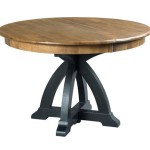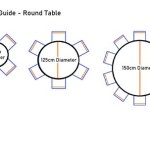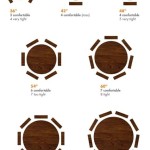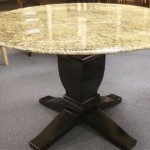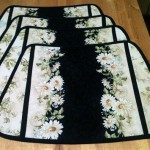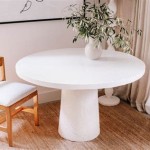What Size Round Dining Table Seats 8?
Selecting the right size dining table is crucial for ensuring comfortable seating, adequate space for place settings, and an overall aesthetically pleasing dining area. For those seeking a round table to accommodate eight individuals, several factors come into play. Understanding the necessary dimensions and considering additional space for movement is essential for making an informed decision.
The primary consideration is the diameter of the round table. While there are general guidelines, these can fluctuate depending on individual body size, chair dimensions, and desired spacing between diners. A smaller table might technically seat eight, but it could result in a cramped and uncomfortable dining experience. Conversely, a table that is too large can dominate the room and hinder conversation across the table.
Minimum Diameter Requirements
The generally accepted minimum diameter for a round dining table intended to seat eight people comfortably is 60 inches (5 feet). This diameter allows for approximately 23.5 inches of personal space per person around the circumference. This measurement is considered the bare minimum and may feel somewhat restrictive, especially if the chairs are particularly wide or bulky.
It's important to visualize the space each person will occupy. Imagine placing eight dinner plates around the table's perimeter. If they seem too close together, or if there isn't sufficient room for elbows, a larger table is recommended. Remember that dinnerware varies in size, and some individuals prefer larger serving dishes, which will require additional table space.
Consider the style of dining that will typically occur at the table. If family-style meals with numerous serving dishes are common, a larger table will undoubtedly be more appropriate. Conversely, if meals are typically plated in the kitchen, a slightly smaller diameter might suffice.
The tablecloth can also affect the perceived space. A tablecloth that is too small can make the table seem smaller than it is, while a tablecloth that drapes too far can be a tripping hazard. Ideally, the tablecloth should hang approximately 12 inches over the edge of the table.
Optimal Diameter for Enhanced Comfort
For a more comfortable and less cramped dining experience, aiming for a diameter of 66 inches (5.5 feet) to 72 inches (6 feet) is preferable. This provides more personal space and allows diners to move more freely without bumping elbows. A table within this range also offers ample room for centerpieces and serving dishes without overwhelming the available space. This size range ensures a more relaxed and enjoyable dining atmosphere.
When selecting a table diameter within this range, it's important to consider the overall room size. While a larger table offers more comfort, it should not overwhelm the dining area. Measure the room carefully and leave sufficient space around the table for chairs to be pulled out comfortably and for people to walk around without obstruction. A general rule of thumb is to leave at least 36 inches of clearance between the edge of the table and any walls or furniture.
The chair style also plays a crucial role in determining the optimal table size. Chairs with arms will require more space than chairs without arms. Similarly, larger, upholstered chairs will take up more room than smaller, more minimalist chairs. Before purchasing a table, it's advisable to measure the width of the chairs that will be used and factor this into the overall space requirements.
Think about how frequently the table will be used to seat eight people. If it's a daily occurrence, prioritizing comfort and space is paramount. If the table is primarily used for smaller gatherings and only occasionally needs to accommodate eight, a slightly smaller diameter might be acceptable, particularly if space is limited.
Beyond Diameter: Other Considerations
Beyond the diameter, several other factors influence the suitability of a round dining table for eight people. These include the table's base, material, and overall style, as well as the surrounding room environment.
The table base is a critical element that affects both stability and legroom. A pedestal base offers the most legroom, as there are no legs to obstruct movement. However, pedestal bases can sometimes be less stable than tables with four legs, particularly with larger diameters. Tables with four legs should have legs positioned far enough apart to allow comfortable seating without leg interference. It is crucial to ensure the base is sturdy enough to support the table top and withstand regular use.
The material of the table top affects both its appearance and durability. Wood is a classic and versatile choice that complements a wide range of decor styles. Glass table tops are modern and can create a sense of openness in a room, but they may require more frequent cleaning to remove fingerprints and smudges. Stone table tops, such as marble or granite, are durable and elegant but can be heavy and expensive.
The style of the table should complement the overall aesthetic of the dining area. A rustic farmhouse table will look out of place in a sleek, contemporary setting. Consider the colors, textures, and patterns in the room to choose a table that blends seamlessly with the existing decor.
Lighting can significantly impact the dining experience. Ensure that the table is adequately lit with a chandelier, pendant lights, or recessed lighting. The lighting should be bright enough to allow diners to see their food clearly, but not so harsh as to create glare or discomfort. Dimmer switches can be helpful for adjusting the lighting to suit different occasions.
The shape of the room also influences the suitability of a round table. Round tables work well in square or octagonal rooms, as they create a sense of balance and symmetry. In long, rectangular rooms, a round table may feel out of place. However, strategic placement and the addition of other furniture can help to integrate a round table into a rectangular space.
Finally, consider the budget. Dining tables can range in price from a few hundred dollars to several thousand dollars, depending on the materials, craftsmanship, and brand. Set a realistic budget before beginning the search and prioritize the features that are most important, such as size, material, and style.
In conclusion, determining what size round dining table seats eight requires careful consideration of various factors, including minimum diameter requirements, optimal dimensions for comfort, chair size, room size, and personal preferences. Taking the time to analyze these elements ensures the selection of a table that provides both functionality and aesthetic appeal, creating an inviting and enjoyable dining space.

Round Dining Tables Connecticut In Style Table Sizes Dimensions 8 Person

Round Table Seating Guide Diy Kitchen Dining Room

Dining Table Dimensions Measurements

Revit Family Round Dining Tables Post Digital Architecture

100 Round Table Seats 8 Diameter Cool Apartment Furniture Check More At Http Livelylighting Dining Sizes Dimensions Kitchen

Round Dining Table Seats 8 Transitional Room Benjamin Moore Morning Dew Paul Moon Design

How To Calculate The Best Dining Table Size For Your Room

Round Dining Tables Ideas Tips Artisan Crafted Iron Furnishings And Decor Blog
What Is The Standard Size Of An 8 Seater Dining Table Quora

The Dining Room Table Size Guide Ideal Sizes For 4 6 And 8 Seater Tables
Related Posts

